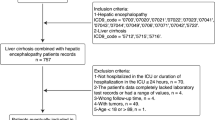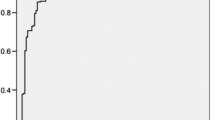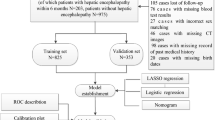Abstract
This study was carried out in Japanese patients to clarify the state of liver cirrhosis complicated by hepatic encephalopathy with and without hepatocellular carcinoma and its prognosis. The subjects were 100 patients with liver cirrhosis complicated by hepatic encephalopathy. Clinical data were investigated, and prognostic factors were extracted using Cox's proportional hazard model. The cumulative survival rate after the first episode of hepatic encephalopathy was 59.1% after 1 year, 48.3% after 2 years, and 22.2% after 5 years. The prognostic index (PI) was calculated using the following formula consisting of these six factors. PI = 0.806 × Child–Pugh classification + 1.149 × presence or absence of HCC + 0.024 × BUN + 0.036 × LDH + 0.093 × WBC + 0.381 × PIVKA-II. The PI value was suggested to be useful for the prognosis of liver cirrhosis after the first episode of hepatic encephalopathy.
Similar content being viewed by others
REFERENCES
Bustamante J, Rimola A, Ventura PJ, Navasa M, Cirera I, Reggiardo V, Rodes J: Prognostic significance of hepatic encephalopathy in patients with cirrhosis. J Hepatol 30:890–895, 1999
Abou-Assi S, Vlahcevic ZR: Hepatic encephalopathy. Metabolic consequence of cirrhosis often is reversible. Postgrad Med 109:52–65, 2001
Ikeda K, Kumada H: Long-term prognosis of liver cirrhosis. Nippon Rinsho 52:63–68, 1994 (in Japanese)
D'amico G, Morabito A, Pagliaro L, Marubini E: Survival and prognostic indicators in compensated and decompensated cirrhosis. Dig Dis Sci 31:468–475, 1986
Milani A, Marra L, Siciliano M, Rossi L: Prognostic significance of clinical and laboratory parameters in liver cirrhosis. A multivariate statistical approach. Hepatogastroenterology 32:270–272, 1985
Gentilini P, Laffi G, La Villa G, Romanelli RG, Buzzelli G, Casini-Raggi V, Melani L, Mazzanti R, Riccardi D, Pinzani M, Zignego AL: Long course and prognostic factors of virus-induced cirrhosis of the liver. Am J Gastroenterol 92:66–72, 1997
Christensen E, Krintel JJ, Hansen SM, Johansen JK, Juhl E: Prognosis after the first episode of gastrointestinal bleeding or coma in cirrhosis. Survival and prognostic factors. Scand J Gastroenterol 24:999–1006, 1989
Degos F, Christidis C, Ganne-Carrie N, Farmachidi JP, Degott C, Guettier C, Trinchet JC, Beaugrand M, Chevret S: Hepatitis C virus related cirrhosis: Time to occurrence of hepatocellular carcinoma and death. Gut 47:131–136, 2000
Schuler A, Manns MP: Patients with chronic hepatitis C-Who should not be treated? Can J Gastroenterol 14B:63B–66B, 2000
Sherlock S, Dooley J: Hepatic encephalopathy. InDiseases of the Liver and Biliary System, 6th ed. London, Blackwell Science, 1981, pp 91–106
Eggel H: Uber das primëre Carcinom der Leber. Beitre Pathol Anat 30:506–604, 1901
Pugh RN, Murray-Lyon IM, Dawson JL, Pietroni MC, Williams R: Transection of the oesophagus for bleeding oesophageal varices.Br J Surg 60:646–649, 1973
Schlichting P, Christensen E, Andersen PK, Fauerholdt L, Juhl E, Poulsen H, Tygstrup N: Prognostic factors in cirrhosis identified by Cox's regression model. Hepatology 3:889–895, 1983
Tsuji Y, Koga S, Ibayashi H, Nose Y, Akazawa K: Prediction of the prognosis of liver cirrhosis in Japanese using Cox's proportional hazard model. Gastroenterol Jpn 22:599–606, 1987
Tarter RE, Arria AM, Van Thiel DH: Hepatic encephalopathy coexistent with alcoholism. Recent Dev Alcohol 9:205–224, 1991
Alvarez-Leal M, Contreras-Hernandez D, Chavez A, Diaz-Contreras JA, Careaga-Olivares J, Zuniga-Charles MA, Reynoso MC, Hernandez-Tellez A: Leukocyte arylsulfatase A activity in patients with alcohol-related cirrhosis. Am J Hum Biol 13:297–300, 2001
Gerber T, Schomerus H: Hepatic encephalopathy in liver cirrhosis: pathogenesis, diagnosis and management. Drugs 60:1353–1370, 2000
Nevens F, Broeckaert L, Rutgeerts P, Van Steenbergen W, Fevery J: The long-term morbidity and mortality rate in a cohort of patients with liver cirrhosis and oesophageal varices. Hepatogastroenterology 42:979–984, 1995
Capussotti L, Vergara V, Polastri R, Bouzari H, Galatola G: Liver function and encephalopathy after partial vs direct side-to-side portacaval shunt: a prospective randomized clinical trial. Surgery 127:614–621, 2000
Graudal N, Hubeck B, Bonde J, Thomsen AC: The prognostic significance of bacteremia in hepatic cirrhosis. Liver 7:138–141, 1987
Albers I, Hartmann H, Bircher J, Creutzfeldt W: Superiority of the Child-Pugh classification to quantitative liver function tests for assessing prognosis of liver cirrhosis. Scand J Gastroenterol 24:269–276, 1989
Cardenas A, Gines P, Uriz J, Bessa X, Salmeron JM, Mas A, Ortega R, Calahorra B, De Las Heras D, Bosch J, ArroyoV, Rodes J: Renal failure after upper gastrointestinal bleeding in cirrhosis: incidence, clinical course, predictive factors, and short-term prognosis.Hepatology 34:671–676, 2001
Takagi H, Uehara M, Sakurai S, Yamada S, Takayama H, Saitoh S, Ojima T, Yamada T, Abe T, Kobayashi S: Evaluation of non-surgical treatments of hepatocellular carcinoma-Investigation of the cases with long and short survivals after treatment. J Jpn Soc Cancer Ther 25:757–769, 1990 (in Japanese)
Attali P, Prod'Homme S, Pelletier G, Papoz L, Ink O, Buffet C: Etienne JP: Prognostic factors in patients with hepatocellular carcinoma.Attempts for the selection of patients with prolonged survival.Cancer 59:2108–2111, 1987
Watanabe A, Higashi T, Sakata T, Nagashima H: Serum amino acid levels in patients with hepatocellular carcinoma. Cancer 54:1875–1882, 1984
Okuda H, Nakanishi T, Takatsu K, Saito A, Hayashi N, Takasaki K, Takenami K, Yamamoto M, Nakano M: Serum levels of desgamma-carboxy prothrombin measured using the revised enzyme immunoassay kit with increased sensitivity in relation to clinicopathologic features of solitary hepatocellular carcinoma. Cancer 88:544–549, 2000
Koike Y, Shiratori Y, Sato S, Obi S, Teratani T, Imamura M, Yoshida H, Shiina S, Omata M: Des-?-carboxy prothrombin as a useful predisposing factor for the development of portal venous invasion in patients with hepatocellular carcinoma; a prospective analysis of 227 patients. Cancer 91:561–569, 2001
Author information
Authors and Affiliations
Rights and permissions
About this article
Cite this article
Yoneyama, K., Nebashi, Y., Kiuchi, Y. et al. Prognostic Index of Cirrhotic Patients with Hepatic Encephalopathy with and Without Hepatocellular Carcinoma. Dig Dis Sci 49, 1174–1180 (2004). https://doi.org/10.1023/B:DDAS.0000037808.44897.8a
Issue Date:
DOI: https://doi.org/10.1023/B:DDAS.0000037808.44897.8a




